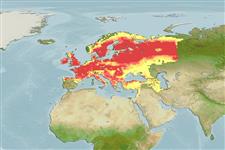Classificação / Names
Common names from other countries
Referência principal
Tamanho / Peso / Idade
Max length : 60.0 cm SL macho/indeterminado; (Ref. 59043); common length : 25.0 cm TL macho/indeterminado; (Ref. 556); Peso máx. publicado: 4.8 kg (Ref. 2058); Idade máx. registada: 22 anos (Ref. 796)
Length at first maturity
Lm 16.8, range 11 - 23.4 cm
Ambiente
; Água doce; estuarina demersal; pH range: 7.0 - 7.5; dH range: 8 - 12; anádromo (Ref. 51243); intervalo de profundidade 1 - 30 m (Ref. 9988), usually 3 - 4 m (Ref. 55947)
Clima / Intervalo
Temperate; 10°C - 22°C (Ref. 1672), preferred ?; 74°N - 38°N, 91°W - 168°E
Distribuição
Eurasia: throughout Europe to northernmost extremity of Scandinavia, except Iberian Peninsula, central Italy, and Adriatic basin; Aegean Sea basin in Matriza and from Struma to Aliakmon drainages; Aral Sea basin; Siberia in rivers draining the Arctic Ocean eastward to Kolyma. Widely introduced. Several countries report adverse ecological impact after introduction.
Países | Áreas FAO | Ecossistemas | Ocorrências | Introduções
Descrição breve
Espinhos dorsais (total): 14 - 20; Raios dorsais moles (total): 13-16; Espinhos anais 2; Raios anais moles: 7 - 10; Vértebras: 39 - 42. Diagnosed from other species of Percidae in Europe by having the following unique characters: pelvic and anal fins yellow to red; posterior part of first dorsal fin with dark blotch; and flank with 5-8 bold dark bars, usually Y-shaped. Differs further by the combination of the following features: two dorsal fins, clearly separated from each other; and 56-77 scales along lateral line (Ref. 59043). Body greenish-yellow; 5-9 transverse black bands on the sides; first dorsal fin gray, black spot at the tip; second dorsal greenish-yellow; pectorals yellow; other fins red. First dorsal fin markedly higher than the second. Caudal fin emarginate (Ref. 2058).
Categoria na Lista Vermelha da IUCN (Ref. 115185)
Ameaça para o homem
Potential pest
Utilização humana
Pescarias: altamente comercial; Aquacultura: espécies comerciais; peixe desportivo: sim
Ferramentas
Relatórios especiais
Descarregue XML
Fontes da internet
Estimates of some properties based on models
Phylogenetic diversity index
PD50 = 0.6250 many relatives (e.g. carps) 0.5 - 2.0 few relatives (e.g. lungfishes)
Nível Trófico
4.4 ±0.0 se; Based on diet studies.
Resiliência
Baixo, tempo mínimo de duplicação da população 4,5 - 14 anos (K=0.1-0.4; tm=2-4; tmax=22; Fecundity=13,000)
Vulnerabilidade
Moderate to high vulnerability (50 of 100)
Categoria de preço
